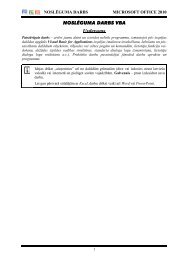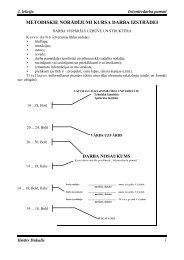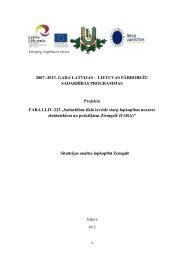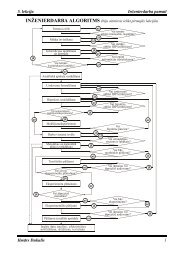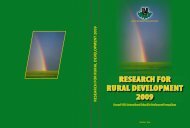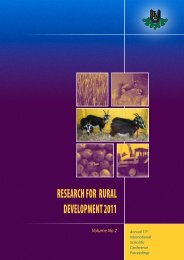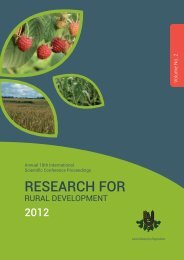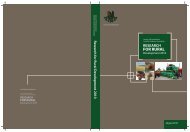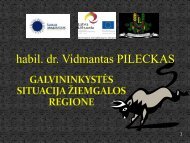LATVIA UNIVERSITY OF AGRICULTURE - Latvijas ...
LATVIA UNIVERSITY OF AGRICULTURE - Latvijas ...
LATVIA UNIVERSITY OF AGRICULTURE - Latvijas ...
- No tags were found...
You also want an ePaper? Increase the reach of your titles
YUMPU automatically turns print PDFs into web optimized ePapers that Google loves.
THE SUITABILITY <strong>OF</strong> DIFFERENT ROWANBERRY CULTIVARSFOR PRODUCTION <strong>OF</strong> FRUIT MARMALADEElga Berna, Solvita Kampuse, Evita StraumiteResults and DiscussionThe physical and chemical parameters (pH value,moisture, total tannins and the content of carotenoids)of the samples of rowanberry marmalades are givenin Table 2. The moisture content of the mass of rawmaterial varied from 55.42% to 64.79%. It wasobserved that during preparation of rowanberrymarmalades, the moisture decreased on average by29.5–42.5%.The results of the statistical analysis indicatethat there are significant differences (p=0.000) in themoisture content among the samples of rowanberrymarmalade. We can compare our results withmoisture content of the rowanberry marmalade andapple-black currant marmalade candies (Berna andKampuse, 2011; Muizniece-Brasava et al., 2011),where moisture content of marmalade was 26.50–37.92% and 44.78%, respectively. According to thesedata we can conclude that marmalade can be called asintermediate moisture food similar to jams and jellies,where moisture content of different berries and fruitjams vary between 27.80 and 34.06% (Figuerola,2007; Ndabikunze et al., 2011).Based on the fact that the pH is critical to successfulgel formation with pectins and low pH increases thepercentage of unionized carboxyl groups, the optimumpH for slow-set pectins being about 3.1 and forrapid set pectins 3.4 is recommended (Baker, 1996).Normally fruits used for making jams and jellies havelow pH; most have less than pH 4.0 and some haveless than pH 3.5. Organic acid (for example, citricacid) stabilizes the relation between pectin and sugar.High acidity, represented by a pH of 3.2 to 3.4, permitsan increased number of unionized carboxyl groups inpectin molecules, reducing the electrostatic repulsionbetween pectin chains (Figuerola, 2007).The pH values of rowanberry marmaladesamples varied from 3.15 to 3.46. The results of thestatistical analysis indicate that there were significantdifferences (p=0.000) in the pH value among therowanberry marmalade samples. As rowanberries,like other berries, have low pH due to their contentof some common organic acids, such as ascorbic,citric, tartaric, and malic acid, then we did not useany of these organic acids for increasing the acidityin fruit marmalade. Similar pH values are reported forthermo-stable marmalades of peach and apples, wherepH value varied from 3.16 to 3.58 (Grujić et al., 2010).The total carotenoids content of all investigatedsamples is reported in Table 1. The differences inthe total carotenoids content between samples of therowanberry marmalades were significant (p=0.000).The highest total carotenoids content was in thesample made from puree of rowanberry S. aucupariavar. sibirica, and the least – in the sample made frompuree of rowanberry × pear hybrid ‘Alaya krupnaya’.The total tannins content significantly differedbetween the rowanberry marmalades (p=0.000), andit was between 0.06 and 0.30 g 100 g -1 DW (Table 1).Wild rowanberry and S. aucuparia var. sibirica hadthe highest content of total tannins, which explainsthe bitterest taste of marmalade made from theseberries compared to marmalades of other rowanberrycultivars and hybrids. We observed that rowanberrymarmalades contain less tannins than unprocessedfruits (Kampuss et al., 2009), which could be affectedboth by the freezing and the processing of therowanberry puree.The results of colour L*a*b* measurements of therowanberry marmalades are shown in Table 3 – colourvalues significantly differed between rowanberrymarmalades (p=0.000). The lightest colour (L* value)was detected to the samples of marmalades fromrowanberry cultivars S. aucuparia var. sibirica and‘Sorbinka’, which berries have yellow-orange colour.Whereas the darkest (the lowest L* value) and thereddest marmalade was prepared from rowanberry× hawthorn hybrid ‘Granatnaya’ and rowanberrycultivar ‘Mitchurinskaya krasnaya’, which berries arecoloured in dark red colour.The average colour L* a* b* values of rowanberry marmaladesTable 3Rowanberry cultivarColour (L* a* b*) valuesL* a* b*‘Granatnaya’ 21.53±1.29 d 9.69±0.80 bc 10.58±1.90 b‘Moravica’ 33.80±0.68 a 9.45±0.86 bc 21.12±1.27 aWild rowanberries 28.45±1.21 bc 18.27±2.13 a 20.48±1.44 aS. aucuparia var. sibirica 35.78±1.58 a 8.47±1.14 c 20.04±1.80 a‘Sorbinka’ 35.03±2.11 a 10.89±1.64 b 22.68±2.15 a‘Mitchurinskaya krasnaya’ 24.33±2.38 cd 10.35±1.68 bc 10.78±1.22 b‘Alaya krupnaya’ 29.43±2.59 b 11.32±1.20 b 8.58±1.14 b* – values, marked with the same superscript letters in a column, are not significantly different (p>0.05).112 Research for Rural Development 2012



